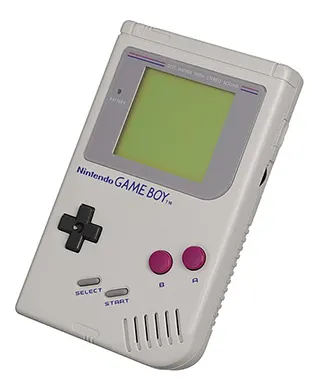The Nintendo Game Boy: A Revolution in Portable Gaming
The Nintendo Game Boy is arguably the defining handheld gaming console. Released in Japan on April 21, 1989, and in North America later that year, it wasn’t the first handheld console, but it was the one that truly captured the world’s imagination and cemented portable gaming as a major force in the industry. Here’s a deep dive into its history, features, impact, and legacy:
History & Development
- Gunpei Yokoi’s Vision: The Game Boy was the brainchild of Gunpei Yokoi, a Nintendo engineer known for his “Lateral Thinking with Withered Technology” philosophy. He believed in using existing, proven technology to create affordable and accessible products.
- Competing with the LCD Competition: The late 80s saw a surge in handheld LCD games, often single-game devices. Nintendo wanted to create a platform for multiple games, a portable console.
- Choosing the Technology: Yokoi opted for a reflective LCD screen instead of a backlit one. This was cheaper, used less battery power (a huge advantage), but resulted in a grayscale display that wasn’t as vibrant as competitors. This decision proved crucial to the Game Boy’s success.
- Launch Titles & Tetris: The Game Boy launched with Tetris as a pack-in title in many regions. This was a stroke of genius. Tetris was incredibly addictive and accessible, and its inclusion was a massive driver of sales. Other launch titles included Super Mario Land and Baseball.
Key Features & Specs
- Processor: 8-bit Sharp LR35902 (a custom CPU based on the Intel 8080 and Z80)
- RAM: 8KB
- Screen: 160×144 pixel reflective monochrome LCD screen (grayscale)
- Sound: 4-channel sound chip (2 pulse wave channels, 1 wave channel, 1 noise channel)
- Controls: D-pad, A & B buttons, Start & Select buttons
- Power: 4 AA batteries (providing roughly 15-30 hours of gameplay)
- Cartridge Format: Proprietary Nintendo Game Boy cartridges
- Link Cable: Allowed for multiplayer gaming and data transfer between consoles.
- Infrared Communication: Used in some games for limited communication.
Models & Revisions
- Original Game Boy (DMG-01): The classic, bulky gray model.
- Game Boy Pocket (MGB-001): Released in 1996, it was smaller, lighter, and had a sharper screen. It required two AAA batteries.
- Game Boy Light (MGL-001): A Japan-exclusive model released in 1998. It featured a backlit screen, making it much easier to play in low-light conditions.
- Game Boy Color (GBC): Released in 1998, it added color to the Game Boy experience and was backward compatible with original Game Boy games.
- Game Boy Advance (GBA): A significant upgrade released in 2001, with a 32-bit processor, a color screen, and improved sound capabilities.
Iconic Games
The Game Boy boasted an incredible library of games. Here are just a few highlights:
- Tetris: The game that launched a thousand consoles.
- Super Mario Land series: Portable Mario adventures.
- The Legend of Zelda: Link’s Awakening: A critically acclaimed Zelda title designed specifically for the Game Boy.
- Pokémon Red, Blue, and Yellow: The games that sparked the Pokémon phenomenon.
- Metroid II: Return of Samus: A challenging and atmospheric Metroid adventure.
- Kirby’s Dream Land: A charming and accessible platformer.
- Donkey Kong Land series: Portable Donkey Kong adventures.
- Wario Land series: Wario’s quirky platforming adventures.
- Harvest Moon: A relaxing and addictive farming simulation game.
Impact & Legacy
- Revolutionized Portable Gaming: The Game Boy proved that portable gaming could be a massive market. It set the standard for handheld consoles for years to come.
- Cultural Phenomenon: Pokémon on the Game Boy became a global cultural phenomenon, introducing a generation to gaming and collectible card games.
- Accessibility & Affordability: The Game Boy’s relatively low price point and long battery life made it accessible to a wide audience.
- Innovation: The Game Boy’s link cable and infrared communication paved the way for future multiplayer and connectivity features.
- Enduring Popularity: Even today, the Game Boy has a dedicated following. Retro gaming enthusiasts collect the consoles and games, and the simple, addictive gameplay continues to appeal to new players. There’s a thriving modding community as well.
- Influence on Modern Handhelds: The Game Boy’s design and gameplay principles influenced the development of later handheld consoles, including the Nintendo DS and 3DS, and even modern mobile gaming.
Why was it so successful?
- Tetris: The killer app.
- Battery Life: Unmatched at the time.
- Price: Affordable for many families.
- Game Library: A diverse and high-quality library of games.
- Portability: Truly pocket-sized and easy to take anywhere.
- Durability: The Game Boy was a surprisingly robust console.
Where to find more information
- Wikipedia: https://en.wikipedia.org/wiki/Game_Boy
- IGN: https://www.ign.com/articles/2009/07/27/ign-presents-the-history-of-game-boy
- Retro Gamer Magazine: Often features in-depth articles on the Game Boy.
- YouTube: Search for “Game Boy history” or specific Game Boy games for documentaries and gameplay videos.
The Nintendo Game Boy wasn’t just a console; it was a cultural icon that shaped the gaming landscape and continues to be celebrated by gamers around the world. Its simplicity, affordability, and incredible library of games made it a truly special piece of gaming history.
